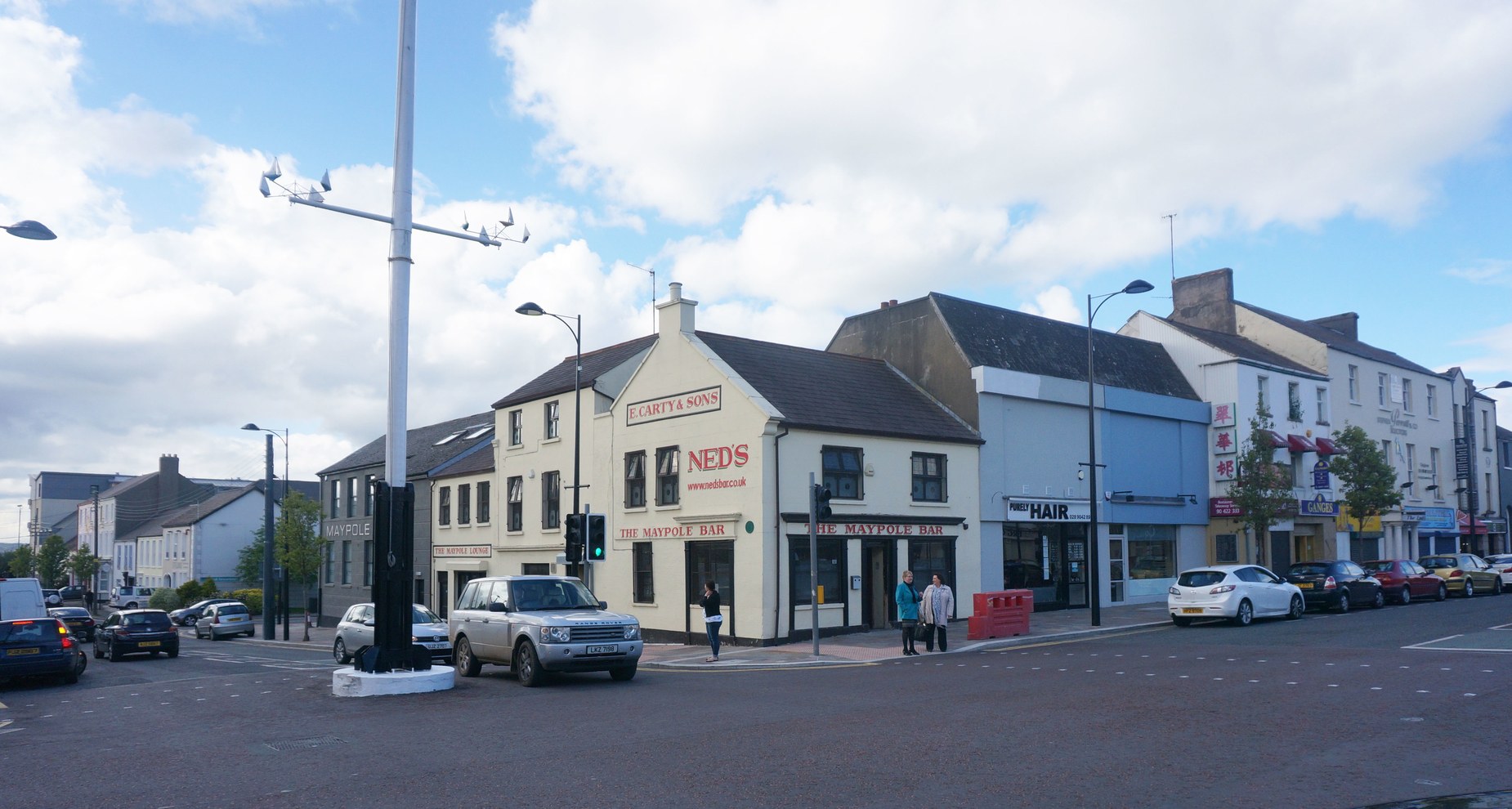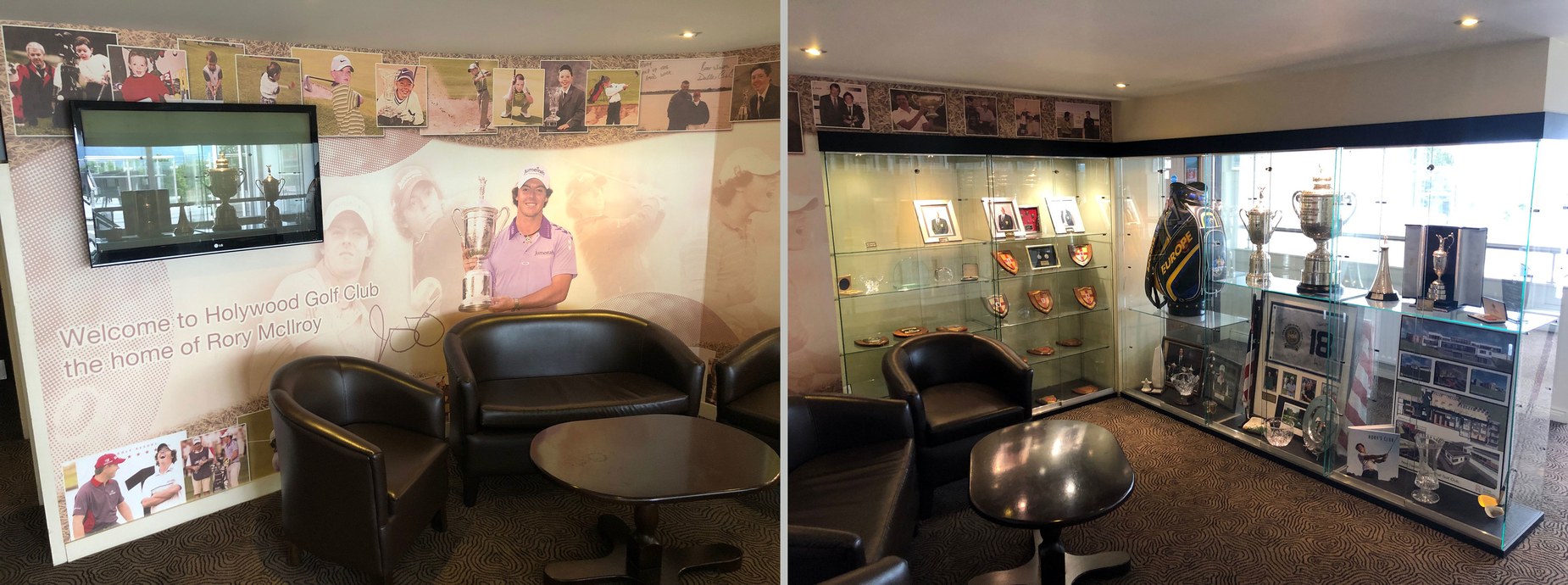By Brian Wacker
HOLYWOOD, Northern Ireland — To the uninformed, a walk down High Street, the main drag lined with shops, cafes and pubs, offers few clues that one of golf’s biggest stars was born and raised in this seaside town of 12,000. You can find the last surviving maypole in all of Ireland—which dates to 1620 and is still decorated with ribbons on the first Monday in May each year, with a May Queen crowned and groups of local school girls dancing around it. But there is no statue or formal tribute to Rory McIlroy.
It’s a fact that isn’t lost among some residents and one that has oft been discussed at council meetings. The short takeaway within a town that traces its history to the year 634 is that such a monument to the 30-year-old four-time major winner would be flattering to the point of embarrassment. Besides, there’s already perhaps a more resonating and impactful structure erected elsewhere that honours him (we’ll get to that in a second).

Brian Wacker
Holywood’s Maypole is the last one standing in Ireland.
There are also subtle homages to McIlroy about town. There are the few framed and signed photographs tucked away in a small booth inside the Dirty Duck, a pub perched hard along the Belfast Lough just down the narrow street from the maypole and where the barmaid confirms that McIlroy still visits every now and again. There’s also a sign that reads, “Welcome to Holywood Borough of North Down, Home of Rory McIlroy” that was put into place 10 months after McIlroy’s 2011 U.S. Open victory. It stands near his old school, Sullivan Upper, and is a sand wedge away from the house where he grew up.
Not that the residents need any reminding from whence McIlroy came. On the Saturday afternoon before Open week kicked off 60 miles to the north in Portrush, an older couple enjoyed lunch in the McIlroy Booth at the Dirty Duck and sounded like proud grandparents extolling the virtues of not just the player he is but the person he’d become. Honest, polite, still grounded (at least relatively so given his enormous wealth and success) in his roots.
“We’re just all proud of him,” Henry Dunne said. “He represents Holywood and the country well.” There’s not a lot of to-do when it comes to McIlroy in his hometown, though there is a large dose of excitement for the return of the Open to his homeland for the first time in 68 years (and only the second time ever). So much so that ticket requests have naturally been pouring into the McIlroy family inbox by the dozens.
Holywood’s low-key connection to McIlroy is an interesting contrast to Portrush, which has always been keen to bask in the success of its native sons. Large signage proudly celebrates two local major champions, Darren Clarke and Graeme McDowell. There are also tributes to McIlroy, notably the scorecard from a course-record 61 that he shot as a 16-year-old during the stroke-play qualifying portion of the 2005 North of Ireland Amateur Open on display in the Portrush clubhouse.
That round, it’s fair to say, is when McIlroy began his ascent to stardom.
“He was three-under through nine holes, and it wasn’t anything amazing,” recalls McIlroy’s close friend Ricky McCormick, who was on the bag that day. “I mean, it was just this two-day qualifier. He’d shot one or two over on the easier Valley Course the day before.
“Then he eagled 10 [on the Dunluce Course] after hitting wedge to about a foot to go to five under. It was like, ‘Wow.’ ”
McIlroy was just getting going. Birdies on Nos. 11, 14, 15 and 16 got him to nine-under on the day and caused him to step back on the old 17th to distance himself from the growing crowd. Aware he could just par in to set the course record (the old mark was 64), he took a few practice swings off on his own, then smoked a 3-wood to the corner of the dogleg on the 504-yard par 5, avoiding the old Big Nellie bunker that guarded the turn. His next shot with a 6-iron found the green, and he two-putted for another birdie.
“When I got to 17 there were so many people that I couldn’t get through the crowds,” McCormick says. “I had to go around the hole just to give him his club.”
On the old 18th, McIlroy again avoided the bunkers that lined the straightaway finishing hole, hit 8-iron to the middle of the green and drained a 20-footer for one last birdie and a closing 28. To put the round in perspective, when the last Open was played at Portrush, in 1951, only two players finished the week under par.
“The 17th at the time was a par 5 and the easiest birdie on the course,” McIlroy said later. “That took me to 10 under and I just thought, Don’t screw this up. I hit a perfect drive and a good 8-iron into the heart of the green. I just wanted to two-putt but ended up rolling it in. I did not care what the score was, I just wanted the course record.”
McIlroy’s score reverberated not just across the island but across the sea to St. Andrews, where Clarke was preparing for that week’s Open Championship. Clarke sent a congratulatory text and word began to spread about the teen phenom’s accomplishment.
A star had been born, and it wasn’t long before McIlroy delivered on his promise, becoming just the third player at the time (Tiger and Jack were the other two) to win four majors by age 25, which included the 2014 Open at Royal Liverpool and that year’s PGA Championship at Valhalla. Afterwards, Nicklaus said, “I think Rory has an opportunity to win 15 or 20 majors or whatever he wants to do if he wants to keep playing.”

Brian Wacker (2)
McIlroy has many of his most significant trophies and memorabilia on display in the renovated Holywood clubhouse.
How big of a star had he become back home?
The Sunday after winning his first major, the U.S. Open at Congressional in 2011, McIlroy was at Ardglass Golf Club an hour south of his hometown to watch a friend play in an amateur tournament. Word spread quickly, and soon hundreds of people started flocking to the course.
“Rory caddied for a few holes before it got a bit out of hand,” says Cormac Chalance, the club’s general manager. “He signed a few things, then had to hop over a wall to escape.”
That was then. Now 30, married and living in Florida with his American wife, Erica, and five years removed from his last major victory, McIlroy isn’t jumping over walls to escape the chaos. Not that it’s easy for him to go out to dinner in his hometown—especially this week.
“After the first couple of majors he won, TV cameras swarmed the club,” says McCormick, who is now the head pro at Holywood. “Members were packing the bar, watching every shot on television. They still do when he’s in contention.
“He’s had to jump a few walls I suppose over the years,” McCormick says. “He’s really good with people, but it’s tough for him sometimes.”
What was less difficult was the decision to display all of McIlroy’s accomplishments in a shrine to his success at the place where he learned the game, Holywood Golf Club. It was equally a no-brainer for him to donate $1 million to the club to help fund what has turned out to be an incredible makeover of its facilities. Once modest with little in the way of high-tech equipment, it is now one of the best facilities in the entire country, tricked out with a sprawling gym, five hitting bays, three TrackMans and two HD Golf simulators that between them have more than 60 courses around the globe available at a few clicks of a mouse.

Paul Faith – PA Images
Fans watch McIlroy win the 2014 Open on TV screens inside the Holywood clubhouse.
McIlroy was awestruck by the finished product when he first saw it two weeks ago. On a recent drive back from Royal Portrush, he called his dad, Gerry, who remains an affable presence in Holywood, and described it in one word: “Unbelievable.”
Even more unbelievable is the impact that McIlroy has been able to have, spawning a whole new generation of players even as participation among kids in Ireland and Northern Ireland has declined.
Thanks to the new digs at Holywood, kids from as far as an hour away are coming there just to train, including Harry O’Hara, who last year won the Irish Junior Open after a runner-up finish the year before.
In many ways, McIlroy is having the same sort of impact on the next generation that Tiger Woods did on his. And that, more than any statue, is the greatest tribute of all.









